Cinnabar Crystal: Properties, Uses, and Historical Significance
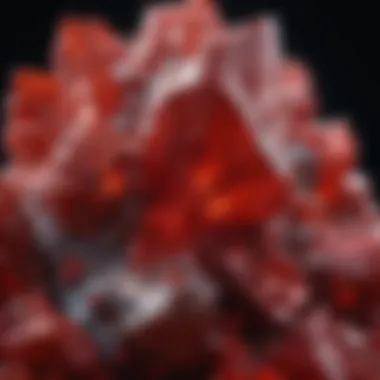
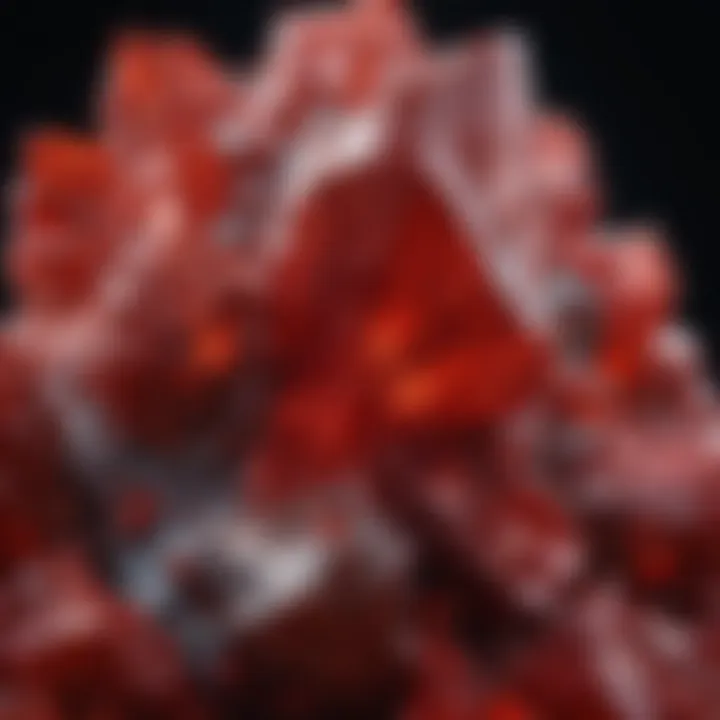
Intro
Cinnabar, a strikingly vibrant red mercury sulfide mineral, has beckoned collectors and enthusiasts alike with its rich hues and historical depth. Often celebrated not just for its aesthetic qualities but also for its intriguing properties, cinnabar crystal weaves a narrative through ancient artistry and modern scientific curiosity. This guide will take you through its multifaceted journey, revealing the mineral's significance in various domains such as geology, art, and alternative medicine.
Understanding cinnabar goes beyond simply admiring its vivid color; it involves delving into how it formed, its mineralogical characteristics, and its roles across cultures and time periods. With rising awareness regarding environmental and health impacts, discussions about cinnabar's extraction provide a crucial aspect of its story. Whether you're a seasoned collector or just discovering the world of minerals, this comprehensive analysis illuminates every nook and cranny of cinnabar's essence.
Featured Collectible of the Month
Overview
As the spotlight of this month, cinnabar crystal embodies an alluring blend of natural beauty and cultural significance. Its deep crimson shade is often paralleled to the hues of a sunset—a notion that perpetuates its allure among collectors.
Cinnabar is not merely a piece of mineral; each specimen possesses its own unique characteristics resulting from factors like locality and geological conditions. From intricately formed crystals to rough specimens, cinnabar's visuals vary much like the stories they tell.
Historical Significance
Historically, cinnabar has held various meanings in different cultures. Ancient Chinese alchemists revered this mineral, believing it to be a source of immortality and a mineral vital in creating the famed vermilion pigment used in traditional painting.
In Mesoamerican cultures, such as the Aztecs, cinnabar was often a part of burial practices, showcasing its perceived spiritual properties. It was not uncommon to find cinnabar in royal tombs, symbolizing regeneration and the afterlife.
Cinnabar's historical roots provide a fascinating context, emphasizing that this mineral has drawn intrigue across continents and centuries, serving purposes both practical and esoteric.
Identification Techniques
Visual Characteristics
To the untrained eye, differentiating cinnabar from other vibrant red minerals may be a challenge. Fortunately, its distinct features make identification manageable. Cinnabar typically exhibits a deep red exterior and may have a slightly shiny luster akin to polished glass. The material can appear in various forms, from granular to crystalline, with some specimens displaying an almost painterly texture—think of a canvas brushed with vivid red paint.
Other identifying traits include:
- Hardness: Cinnabar registers around 2 to 2.5 on the Mohs scale, making it relatively soft compared to many other minerals.
- Streak Test: When scratched against a porcelain plate, it leaves a bright red streak, offering another definitive clue.
Resources for Identification
As knowing the characteristics alone is not always enough, various resources can prove invaluable in identifying cinnabar accurately:
- Wikipedia - Cinnabar
- Britannica - Cinnabar
- Many forums and groups on platforms like Reddit can provide community insights or real-time assistance when identifying minerals.
Understanding these features and resources equips both novices and seasoned collectors alike with the knowledge to appreciate cinnabar to its fullest.
"Cinnabar is not just a mineral; it's a bridge connecting our present to the ancient traditions and practices, invoking an appreciation for both natural beauty and historical journey."
Embracing this delicate yet significant gem enriches the ongoing dialogue about our planet's offerings and its myriad of meanings across different spheres.
Prolusion to Cinnabar Crystal
Cinnabar crystal, a fascinating mineral notorious for its vibrant red hue, is more than just a pretty face. It has a rich history and an array of uses that span from ancient societies to modern applications. This article will delve into the intricate world of cinnabar, exploring its properties, significance, and the implications that accompany its extraction and use. Understanding cinnabar is essential not just for enthusiasts but also for those interested in the intersection of geology, art, and health.
Definition and Characteristics
Cinnabar is essentially the crystalline form of mercury sulfide, with a chemical formula of HgS. It’s distinctly known for its intense red and sometimes orange coloration, insomuch that the name itself is derived from ancient Persian words referring to a certain red pigment. Visually, when encountered, it may display a glassy or resinous luster, leading collectors to marvel at its beauty. Many collectors seek it not just for aesthetic pleasure, but also to understand its unique characteristics deeply.
In terms of structure, cinnabar often appears in massive or granular aggregates; yet it can also form more rare crystalline habits that sparkle with brilliance under the right light. The mineral's behaviors, including notable features like its cleavage and fracture, make it an intriguing specimen for study. Its presence in various geological settings further amplifies its appeal within the mineral collecting community, sparking interest in both novice and seasoned collectors alike.
Chemical Composition
The chemical composition of cinnabar is relatively straightforward. Mercury, a heavy metal, is combined with sulfur, resulting in the striking compound mercury sulfide. The importance of understanding its chemical structure can't be overstated. It impacts both its physical properties and the way it interacts in various applications.
Cinnabar ranks about 2 to 2.5 on the Mohs hardness scale, which indicates it is rather soft as far as minerals go. This softness can influence its fragility but also makes it easier to carve and shape into artistic pieces.
Moreover, the presence of mercury in this mineral has been a double-edged sword. On one side, it allows for brilliant colors and valuable cultural artifacts; on the other side, it raises significant environmental and health concerns. Cinnabar not only captivates with its dazzling appearance but also serves as a reminder of the careful balance we must maintain between utilizing natural resources and safeguarding our planet.
"Cinnabar is a beautiful paradox—its allure captivates, while its hidden dangers remind us of nature's complexity."
In summary, understanding the definition and characteristics of cinnabar provides a foundation for appreciating its role in geology, history, and art. This knowledge sets the stage for deeper exploration into the mineral's formation, its uses across time, and its cultural significance.
Formation and Occurrence
Understanding the formation and occurrence of cinnabar crystal is critical for appreciating its intrinsic significance in both geological and cultural contexts. This knowledge provides insights into how this vibrant mineral form exists naturally, its environmental dependencies, and the processes that lead to its remarkable appearances. The way cinnabar forms is not just a geological footnote but lays a foundation for its industrial applications, historical use, and even its symbolic meanings in various cultures.
Geological Formation Processes

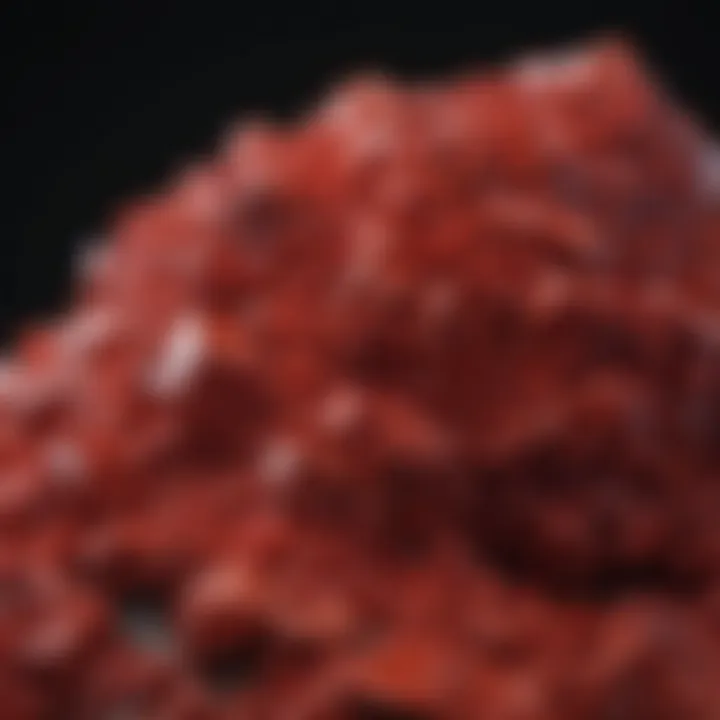
Hydrothermal Processes
Hydrothermal processes play a vital role in the development of cinnabar deposits. These processes involve the movement of mineral-rich hot water through cracks and fissures in the earth’s crust. The solution becomes supersaturated with minerals such as mercury, leading to the precipitation of cinnabar when the temperature and pressure conditions are favorable.
One key characteristic of hydrothermal processes is the ability to produce high-quality crystals formed under extreme conditions. This is especially beneficial for collectors, as the crystals obtained from hydrothermal veins are often more visually appealing and structurally interesting than those from other processes. These veins, filled with beautifully crystallized cinnabar, create stunning showcases for anyone involved in mineralogy or rock collection.
However, there are drawbacks to consider. The conditions that favor hydrothermal deposit formation are not widespread, limiting the locations where high-quality cinnabar can be harvested. As collectors know, availability is a crucial factor, and while these processes contribute to quality, they can result in scarcity in some areas.
Volcanic Activity
Volcanic activity is another significant factor contributing to the formation of cinnabar. When volcanic gases, particularly those containing mercury, escape from the Earth’s depths during eruptions, they may condense and interact with surrounding rock, forming cinnabar deposits. The explosive nature of these geological activities frequently presents opportunities for unique mineral formations.
A key characteristic of this process is rapid mineral growth, which tends to lead to distinctive and complex crystallization patterns. For mineral collectors, this characteristic can add significant value to a specimen. You might find amazing shapes and colors that are not typically available from more stable formation environments.
One unique feature of volcanic activity is that it can lead to supergene enrichment, where existing minerals undergo transformation through atmospheric processes. The main disadvantage, though, is that volcanic regions can be geologically unstable and hazardous areas to collect. These considerations underscore the need for experienced judgment in the field.
Global Distribution
Understanding the global distribution of cinnabar gives insight into why certain locations have become hotspots for collectors and researchers alike. Cinnabar's occurrence tends to be concentrated in specific geological environments predominantly shaped by past volcanic and hydrothermal activities.
Major Mining Locations
Cinnabar’s most notable mining locations span the globe, with regions such as Almaden in Spain and Idrija in Slovenia historically recognized for their rich deposits. These areas have cultivated significant conversation around not just the mineral itself, but also the social and economic impact of mining activities.
The main characteristic of these major locations is the persistent and high-quality output of cinnabar, making them popular among serious collectors and industrial users. This abundance is a major draw but can sometimes pose a downside, as over-extraction can lead to depletion of resources and ecological concerns in their surrounding areas.
Alongside that, awareness of these hotspots can enhance a collector's ability to seek out authentic specimens, as knowledge of origin is crucial in evaluating value.
Regional Variations
Regional variations can influence not only the physical characteristics of cinnabar crystals but also their availability and significance. In countries like China, where cinnabar has deep cultural ties, styles of collection and the types of specimens available can differ significantly from those in the Americas or Europe.
This aspect underscores the variety in crystal formation and aesthetics across different locales, essentially enriching the lore and admiration surrounding cinnabar. There’s real beauty in how local traditions can influence the way these minerals are collected and used.
However, the region-dependent availability of high-quality specimens may hinder collectors who are not able to travel extensively. Understanding these regional differences enhances appreciation and informs choices in collection practices.
In summary, the study of cinnabar's formation and occurrence is not just about geology; it encapsulates historical, cultural, and practical dimensions that enrich our understanding of this remarkable mineral.
Physical Properties
Understanding the physical properties of cinnabar crystal is crucial for rock and fossil collectors, as these characteristics form the foundation of identification, valuation, and overall appreciation of this striking mineral. Physical properties provide insights into the crystal's formation, potential uses, and even its historical significance. Focusing on color, luster, hardness, and structure allows collectors to discern the quality and authenticity of their specimens, making this knowledge indispensable.
Color and Luster
Cinnabar is primarily recognized for its vibrant red color, which can range from deep crimson to a lighter, reddish-brown shade. This hue results from the mineral's mercury sulfide composition, giving it a distinct identity among various minerals. Its color is not just a visual treat; it plays a pivotal role in its cultural significance, often symbolizing vitality and power in different societies.
The luster of cinnabar can be described as resinous to metallic, which adds to its allure. This reflective quality can make the crystals gleam under light, creating an enchanting display that has captivated collectors and artists alike for centuries. Its luster is one of the features that set it apart from similar minerals, allowing enthusiasts to appreciate the more nuanced details that emerge in natural light.
However, one must be cautious; judging the quality based solely on color can be misleading. Variations in the shades may arise due to impurities or the specific geological conditions under which the crystal formed. Thus, understanding the full context of the stone’s environmental history is equally important, providing depth to the true value of a specimen.
Hardness and Structure
The hardness of cinnabar is relatively low on the Mohs scale, registering around 2 to 2.5. This brittleness indicates that while it may be attractive, it is also quite delicate. Collectors should take care, as inappropriate handling can result in chipping or breaking. The crystal structure adopts a rhombohedral form, characterized by its layered arrangement, which also influences how the mineral cleaves.
Such properties emphasize the necessity of proper care and storage for collectors. Recognizing the crystalline structure helps distinguish it from other similar-looking minerals, thus ensuring that a collector can present a well-informed narrative behind their specimens. Moreover, the softness and unique structural traits make cinnabar unsuitable for everyday jewelry; its beauty is best appreciated in mineral collections or art pieces.
In summary, the physical properties of cinnabar not only define its aesthetic appeal but also contribute to its scientific and historical significance. Collectors keen on understanding these characteristics will not only enhance their knowledge but also appreciate the potential stories behind each specimen. As they say, knowing is half the battle, and in the world of minerals, deeper knowledge leads to finer collections.
"Cinnabar’s striking color and unique structure tell tales of Earth’s processes. Understanding these traits adds layers to a collector's passion."
With this insight into color, luster, hardness, and structure, collectors can become more effective stewards of their treasures. Recognizing the delicate interplay between physical properties and historical context will surely enrich their collecting journey.
Historical Significance
The historical significance of cinnabar crystal cannot be underestimated. Not only has this mineral been a part of various ancient cultures, but it also reflects the human connection to the earth and its resources across centuries. From art and decoration in ancient civilizations to its roles in traditional medicine and alchemy, cinnabar has been cherished and utilized for its unique properties. This section dives into how its history shaped cultural practices and provided insights into the social and economic dimensions of ancient societies.
Use in Ancient Cultures
Chinese Artifacts
Cinnabar has deep roots in Chinese culture, especially in the realm of art and decoration. Traditional Chinese artisans crafted exquisite works using this mineral. Lacquerware, which imbues objects with a glossy finish, often incorporated cinnabar as a pigment. The vibrant red color derived from cinnabar was believed to ward off evil spirits, making these artifacts not just objects of beauty but also talismans of protection.
- Key characteristics of Chinese artifacts include their intricate carvings and rich symbolic meanings. Such artifacts demonstrate a harmony of aesthetics and functionality.
- The unique feature of using cinnabar in lacquerware is its ability to create a stunning depth of color while offering protection to the wooden base underneath.
- However, one must consider the safety aspects of cinnabar; the toxicity of mercury if the artifacts are chipped or damaged poses a serious risk.
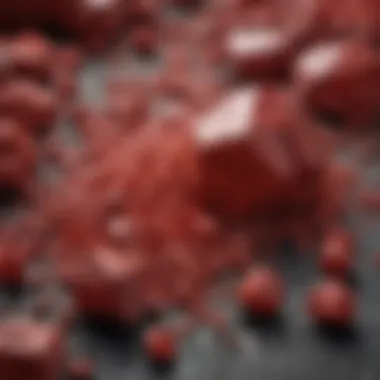
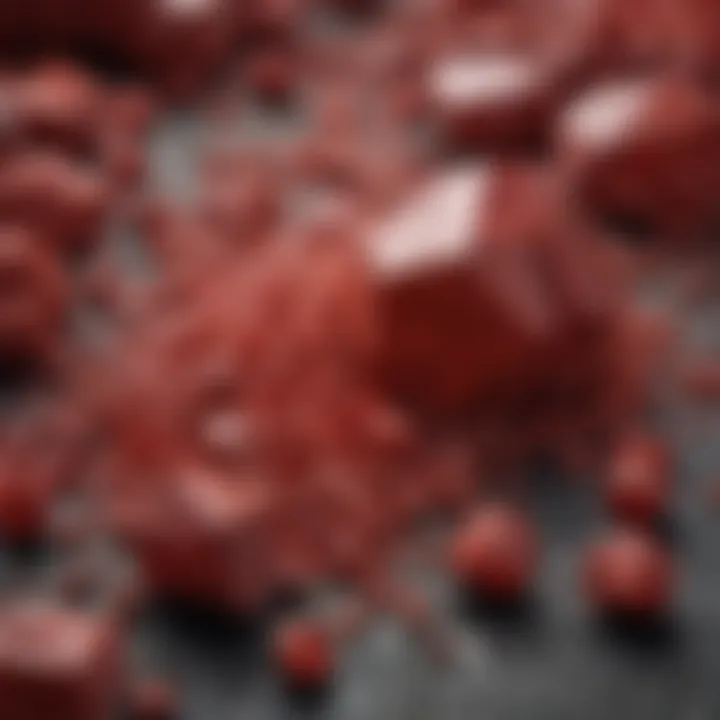
Overall, the combination of beauty and lore associated with cinnabar makes it an invaluable reference point in the study of ancient Chinese culture.
South American Practices
In South America, particularly among indigenous cultures, cinnabar also found significant application, primarily in rituals and art. The pigment was used in various forms, often mixed with other substances for ceremonial purposes. It played a role in the burials of elites, where a bright red powder would be placed over the deceased.
- The key characteristic of South American practices is the spiritual significance attached to the color red, representing life and vitality, which is profound in cultural narratives.
- What stands out in these practices is the unique feature of using cinnabar as a transformative medium in funerary contexts. This highlights the intersection of material culture with spiritual beliefs.
- On the downside, the initial allure of bright color can be overshadowed by the health risks associated with mercury exposure during the mining process or the handling of the pigment.
These examples foster an understanding of cinnabar as not merely a decorative object but rather as an entity intertwined with cultural identity.
Adoption in Medicine and Alchemy
Throughout history, cinnabar has held a notorious reputation in both alchemical and medicinal practices. Ancient civilizations harnessed its properties in various ways, believing it could communicate with the spirit world or serve as a remedy for ailments. The practice of alchemy sought to transform base materials into more valuable substances; it was here that the red pigment became a symbol of transformation itself.
In traditional medicine, some cultures even believed that consuming a small dose could impart physical strength and vitality. However, this often led to adverse health effects due to the toxic nature of mercury. Thus, its use embodies a double-edged sword: promising recovery but potentially paving the way for severe consequences.
Important Note: Always consider the historical context when examining these practices to understand how ancient knowledge shaped modern interpretations of health and wellness.
Modern Applications
The role of cinnabar crystal in today's world extends far beyond its historical significance or aesthetic appeal. This section delves into its modern uses across various fields, demonstrating how its unique properties can be harnessed in practical, innovative ways. From artistic endeavors to industrial applications, its versatility is key.
Use in Art and Craft
Cinnabar has found its way into artistic expressions, where its captivating red hue mesmerizes artists and craftsmen. This mineral is often employed in jewelry making, where its striking colors can create standout pieces that symbolize creativity and fortune. Many jewelers appreciate its rich tonal quality, pushing the boundaries of conventional designs.
Moreover, it’s becoming popular in mixed media arts. When artists blend cinnabar with other materials, they evoke narratives that touch on its historical roots and cultural significance.
Some artisans experiment with cinnabar in painting as well, although it requires careful handling due to its toxicity.
Industrial Applications
Pigment Production
In the realm of pigment production, cinnabar's vivid red tones are unparalleled. The unique coloring agent derived from this mineral is particularly sought after for its durability and vibrancy. Often used in traditional paint formulations, particularly within fine art and decorative applications, it lends a sense of depth that synthetic alternatives struggle to replicate. However, its use comes with notable downsides, primarily tied to safety concerns due to mercury content. Many industries are thus re-evaluating their usage of cinnabar as they seek safer alternatives.
Chemical Use
Cinnabar also plays a role in various chemical processes, specifically in the production of mercury. This chemical has applications that range from industrial manufacturing to thermometers. Despite its undeniable utility, the processes surrounding cinnabar necessitate stringent safety precautions. The benefits of its use must invariably be weighed against the environmental and health risks posed by mercury, as the balance is delicate and demand for safer solutions on the rise.
Alternative Healing Practices
Some advocate for the use of cinnabar in alternative healing practices. Believers often claim it helps in energy balancing and emotional well-being. Different traditions view this crystal as a powerful tool for creativity and motivation. It is essential, however, to approach these claims with a skeptical eye, recognizing that while minerals can be inspiring, they should not replace professional medical treatment.
In summary, the breadth of cinnabar’s modern applications showcases its enduring relevance. As we navigate its industrial uses, artistic possibilities, and alternative healing significance, a careful approach is necessary to fully appreciate its benefits while mitigating associated risks.
Cultural Perspectives
Understanding the cultural perspectives surrounding cinnabar crystal offers a rare glimpse into the ways humanity interacts with this remarkable mineral. From ancient rituals to modern artworks, cinnabar has transcended its physical form to become a vessel of meaning across various societies. Acknowledging these cultural influences not only enriches the narrative surrounding this striking red mineral but also underscores the significance of its historical and contemporary roles.
Symbolism in Various Cultures
Cinnabar has long been more than just a beautiful mineral; its rich color and unique properties have rendered it significant in numerous cultures around the globe. In Chinese culture, for example, cinnabar is considered a symbol of vitality and immortality. This belief stemmed from its association with both longevity and wisdom. Ancient Chinese alchemists prized it for its alleged ability to transform base elements into gold, linking it to notions of power and transcendence. Likewise, the deep connection between cinnabar and feng shui practices demonstrates its importance as a source of protection and harmony in residences and workplaces.
In South America, particularly among the indigenous groups of the Andes, cinnabar bore profound spiritual implications. Its presence in gravesites suggested that it served as a conduit for the deceased, bridging worlds and facilitating the journey to the afterlife. This belief imbued the mineral with a sacred status, marking it as an essential constituent of funerary rituals.
The symbolism of cinnabar transcends borders, as it can also be seen in African cultures, where its vivid hue often represents blood, life, and fertility. The duality of its vibrant color contrasts sharply with its toxicity, provoking reflections on life and death.
"Cinnabar not only captivates with its beauty but also encloses rich narratives within its delicate layers."
The allure of this crystal lies not just in its physical attributes but in the multifaceted meanings bestowed upon it by cultures worldwide. Each interpretation offers valuable insights into the values, fears, and aspirations prevalent in those societies.
Influence on Literature and Art
Cinnabar's striking appearance and rich history have dramatically influenced art and literature through eras. In literature, references to cinnabar often carry potent metaphorical weight, with writers invoking its vivid hue to evoke themes of passion, danger, or transformation. For instance, in poetry or prose discussing the ephemeral nature of beauty, cinnabar may serve as a compelling symbol of fleeting splendor.
Artists, too, have been profoundly influenced by this mineral. Throughout history, its brilliant red pigment found its way into paintings, with renowned artists like Rembrandt and Diego Rivera employing it to impart depth and intensity. In contemporary art, the daring use of cinnabar asserts a bold statement about materiality and the art of the earth. The texture and boldness of the color stimulate discourse about environment, culture, and the essence of creation.
Moreover, the practice of incorporating minerals like cinnabar into crafts and jewelry thrives today—breathing new life into age-old techniques while reflecting personal stories and cultural identities. As can be seen, both literature and visual arts capture the spirit of cinnabar, portraying it as a multi-layered emblem reflecting human experience.
In summary, understanding the cultural perspectives surrounding cinnabar crystal reveals the underlying tapestry of meaning woven throughout history. Its symbolism and influence in art and literature provide significant insight into human connections, artistic expression, and collective memory, enriching our appreciation of this captivating mineral.
Health and Safety Considerations
When it comes to collecting and handling minerals like cinnabar crystal, understanding health and safety considerations is paramount. Cinnabar, as beautiful as it may appear, presents certain risks that can’t be overlooked. It's crucial for collectors and enthusiasts to grasp the implications of its chemical makeup, especially when it comes to toxicity. This section navigates through these concerns, ensuring that both newcomers and seasoned collectors are well-informed about handling this striking crystal safely.
Toxicity of Cinnabar

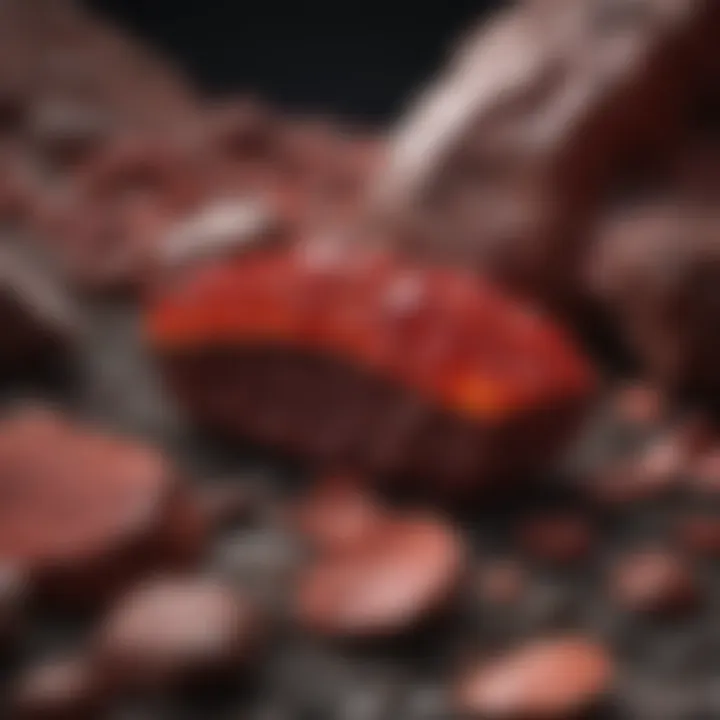
Cinnabar primarily consists of mercury sulfide (HgS). Mercury is notoriously known for its toxicity, and cinnamon's vibrant red hue belies the danger it poses. Exposure to mercury can lead to serious health complications, including:
- Neurological Effects: Symptoms can range from tremors to cognitive dysfunction.
- Respiratory Issues: Inhalation of mercury vapors can cause severe lung damage.
- Skin Irritations: Direct contact with cinnabar can lead to rashes or more severe skin issues.
Due to its mercury content, it’s essential to approach cinnabar with caution. The World Health Organization warns against prolonged exposure to any form of mercury, and collectors should heed these guidelines. Understanding the symptoms of mercury poisoning is vital; if any effects are noted, immediate medical attention is vital.
Safe Handling Practices
To mitigate the risks associated with cinnabar crystal, adopting stringent handling practices is non-negotiable. Here are some best practices:
- Personal Protective Equipment (PPE): Always wear gloves and masks when handling cinnabar. This creates a barrier between the skin and the crystal, minimizing exposure.
- Work in a Ventilated Area: Ensure the space where you handle cinnabar is well-ventilated. This helps disperse any potentially harmful vapors that could be released:
- Storage: Store cinnabar in a safe, non-porous container. Label it clearly as hazardous material to deter accidental contact.
- Hygiene Practices: Wash your hands thoroughly after handling the mineral, even if you wore gloves. Avoid touching your face until you have cleaned your hands.
- Educate Yourself: Always remain informed about any new findings or protocols related to cinnabar handling and storage.
- Open windows or use ventilators.
- Avoid handling it in enclosed spaces.
"Knowledge is power. In the case of handling materials like cinnabar, it also means safety."
By prioritizing these safe handling practices, collectors can appreciate the beauty of cinnabar while safeguarding their health. It's not about fearing this captivating crystal, but respecting its characteristics and consequences, ultimately leading to a more enjoyable and safe collecting experience.
Environmental Impact
Understanding the environmental impact of cinnabar crystal is crucial for those engaged in its collection, mining, and study. The extraction of cinnabar, primarily sourced for its vibrant coloring and historical applications, raises questions not just about human health but also about ecological balance. As collectors and enthusiasts navigate this captivating mineral world, awareness of its environmental implications ensures that personal interest aligns with sustainability.
Cinnabar mining can bring about seismic changes to local habitats, affecting flora and fauna. Often, mining operations can disrupt ecosystems, leading to soil erosion and altering water pathways. Moreover, contains high levels of mercury, which can pose significant hazards to nearby aquatic systems. It’s crucial to balance the economic benefits against the potential environmental degradation that such mining practices can unleash.
"Sustainability isn’t just a buzzword; it’s a necessity for the future of minerals like cinnabar."
Mining Practices and Sustainability
The relationship between mining practices and sustainability is predominately shaped by the methods employed in the extraction of cinnabar. Traditional mining tends to extract large amounts of material, often leading to indiscriminate land disruption. On the flip side, modern techniques are gradually incorporating more sustainable approaches.
- Selective Mining: This method focuses on extracting only the cinnabar-rich areas, minimizing land impact. This reduces unnecessary harm to the surrounding environment and helps maintain biodiversity.
- Reclamation Efforts: After mining operations conclude, land reclamation becomes pivotal. This process involves restoring the landscape to its original form or even improving it through environmental enhancement methods, such as planting native species that bolster the local ecosystem.
Another aspect to consider is the use of technology in reducing the environmental footprint. Employing advanced machinery and techniques can lessen the demand for land, water, and energy resources. Collaboration between mineralogical experts and environmental scientists is essential in shaping practices that protect our natural world while allowing for the continued appreciation of cinnabar.
Regulatory Framework
Regulation plays a significant role in governing the impact of cinnabar extraction on the environment. Various international treaties and national laws aim to protect ecosystems while managing the mining industry. Countries with rich mineral resources, including cinnabar, often exhibit a patchwork of regulations that vary widely. This can complicate global efforts for sustainability.
- Compliance with Environmental Laws: Operators must adhere to local laws that dictate safe extraction and handling of hazardous materials like mercury. This includes ensuring that emissions do not exceed preset limits and that water sources remain uncontaminated.
- Impact Assessments: Many regions now require mining companies to conduct comprehensive environmental impact assessments prior to starting operations. These assessments examine everything from local wildlife to water quality, ensuring all potential effects are considered before any site development begins.
In essence, the regulatory framework surrounding cinnabar mining must be robust and adaptable, holding companies accountable while fostering responsible practices that prioritize and protect our planet. With thoughtful consideration of these elements, the world of cinnabar can thrive without sacrificing the environment.
Collecting Cinnabar Crystal
Collecting cinnabar crystal opens up a unique world where enthusiasts uncover not only the beauty of this striking mineral but also its historical and scientific significance. This section explores the nuances of collecting this vivid red mineral, emphasizing the importance of identification and care. For both amateur and seasoned collectors, gathering information about the extraction, the right way to identify, and how to preserve these specimens is crucial. Such knowledge ensures the longevity of their collection as well as safety, given the mineral's toxic nature.
Identification Tips for Collectors
Identifying authentic cinnabar is key for collectors looking to build a high-quality collection. Due to its vibrant red hue and remarkable luster, distinguishing it from lookalikes can be challenging. Here are some specific tips:
- Visual Inspection: True cinnabar crystals are usually bright red with a metallic sheen. Look for this distinctive color in a well-lit area. The presence of a dull finish or color variations could indicate a different mineral.
- Hardness Test: Cinnabar typically scores about 2 to 2.5 on the Mohs scale. If you have a scratch testing kit, try scratching a clear glass surface. If the mineral leaves a mark, it’s likely not cinnabar, as the crystal is relatively soft.
- Weight Check: Cinnabar has a specific gravity of about 8.1 g/cm³, making it heavier than many common minerals. Weighing your specimen or comparing it to other minerals of similar size can help confirm its identity.
- Color Consistency: Genuine cinnabar shows consistency in color throughout the piece. Be cautious of samples with uneven coloring, as this may point toward artificial alterations or synthetic replicas.
- Seek Expert Validation: When in doubt, asking someone with experience in mineralogy or a local gem and mineral society can provide clarity. Their insights could save you from investing in fakes.
"Every piece tells a story, but it's the collector's job to listen carefully to the tale behind the minerals."
Care and Preservation Techniques
Proper care of collected cinnabar crystals not only maintains their aesthetic value but also ensures safety. Here are some effective methods for preserving your treasures:
- Avoid Direct Sunlight: Prolonged exposure can fade the vibrant colors of cinnabar. It's wise to display them in shaded environments, minimizing light damage.
- Store in a Controlled Environment: Cinnabar crystals should ideally be kept in a climate-controlled area to avoid humidity. Storing them in a glass display case can provide protection from dust and physical damage.
- Clean Gently: When cleaning your specimens, use a soft brush or damp cloth. Avoid harsh chemicals or abrasive materials that could scratch the surface.
- Use Gloves: Given its toxicity, handling cinnabar without gloves is inadvisable. Wearing gloves prevents oils and residue from contaminating the crystal surface and limits direct contact with any potential powder.
- Regular Inspections: Periodically check your collection for any signs of deterioration or damage. Catching potential issues early can help preserve your collection's integrity.
The End
The conclusion serves as a critical juncture in understanding the broader implications of cinnabar crystal. It encapsulates key insights and provides a foundation for appreciating its multifaceted nature, covering both historical and contemporary aspects. Exploring the importance of this section in the context of the entire article invites readers to synthesize the information gleaned throughout the text, enhancing their comprehension and insight into the subject matter.
Summary of Key Insights
In summarizing the insights gained from the extensive analysis of cinnabar crystal, several core points emerge. Firstly, the unique properties of cinnabar, marked by its brilliant red hue and distinct luster, make it not only a fascinating mineral but also a significant artifact in both art and scientific applications. The crystal's chemical composition, predominantly mercury sulfide, is pivotal in its function and usage within various cultural and industrial realms.
Cinnabar’s historical significance cannot be understated. Its utilization by ancient civilizations—most notably in Chinese culture where it was used in traditional medicine and art—demonstrates a long-standing interaction between humans and this mineral. Moreover, the practical applications today in art, industrial manufacturing, and alternative practices highlight how little has changed in our appreciation for this unique substance.
Finally, the health and environmental concerns tied to cinnabar, particularly its toxicity, have prompted a shift in both mining practices and safety regulations. This highlights the necessity for awareness and responsible handling when engaging with cinnabar crystals in any form.
Future Directions of Research
Looking ahead, there remain ample avenues for further exploration regarding cinnabar crystal. Future research could delve into alternative extraction methods that mitigate environmental damage or focus on the restoration of depleted cinnabar mining sites. There is also a need for comprehensive studies into the health impacts that exposure to cinnabar may have on miners and collectors alike.
Moreover, the realm of alternative healing practices using cinnabar is ripe for investigation, creating opportunities for interdisciplinary research combining geology, medicine, and cultural studies. This could lead to a better understanding of how cinnabar can be safely utilized in wellness circles without compromising health.
In summary, as the fascination with cinnabar continues, extensive research efforts, both practical and theoretical, can enhance our understanding and appreciation of this striking mineral, driving both academic inquiry and practical applications in interdisciplinary fields.



